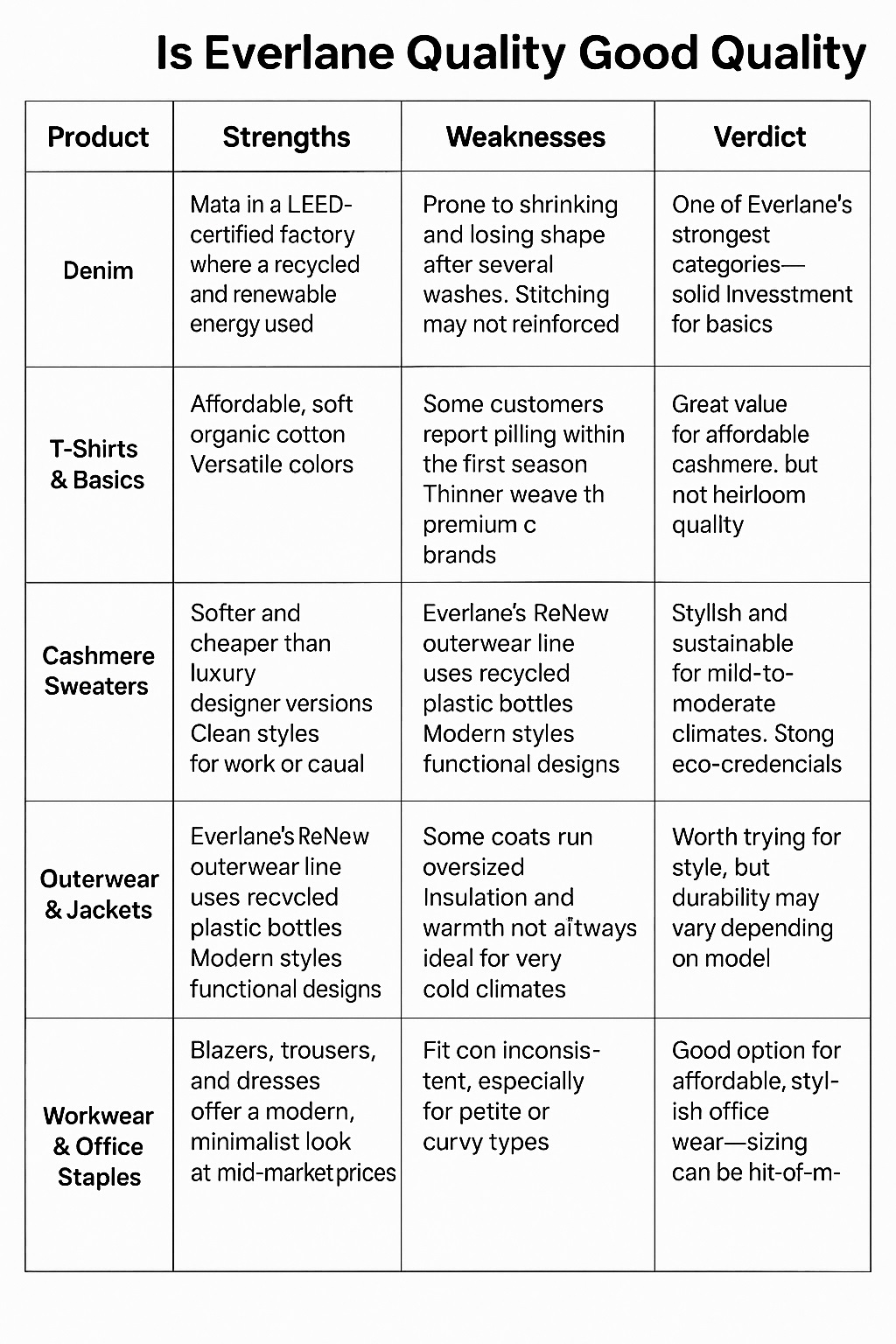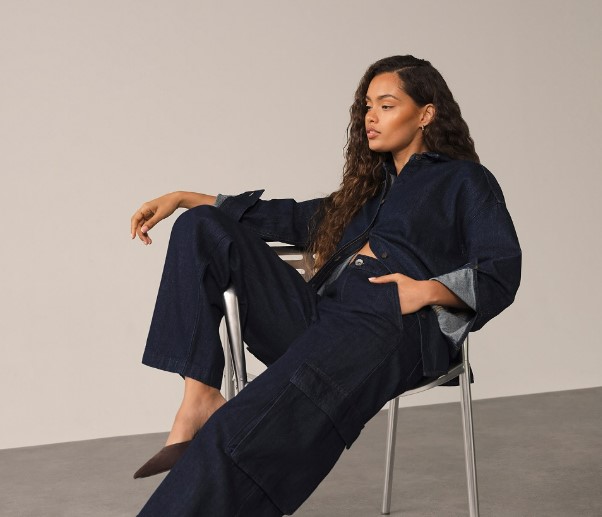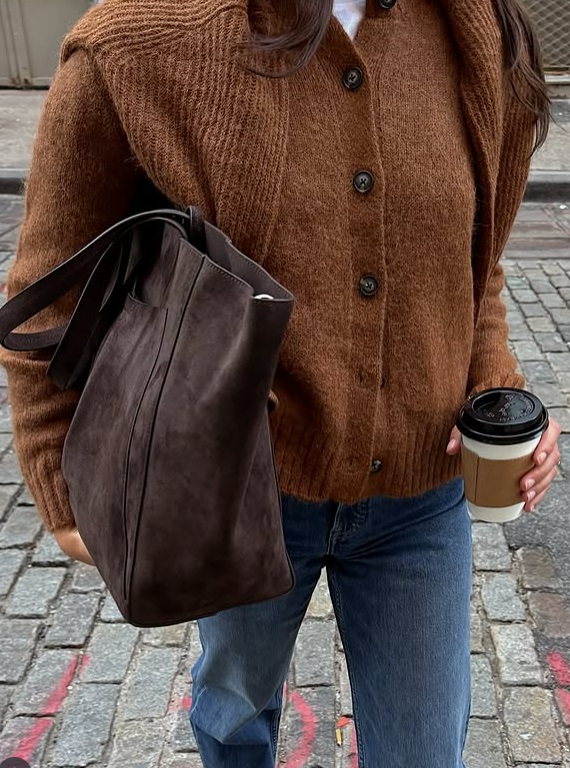Everlane is one of the most talked-about names in sustainable fashion. The company promises “radical transparency” and claims to make high-quality basics that are better for people and the planet. But does Everlane truly live up to the hype, or is it more marketing than substance?
Is Everlane a Good Brand?
Yes, Everlane is a good brand for people who want affordable basics and some eco progress. The company uses organic cotton, recycled fabrics, and shares details about its partner factories.
But there are limits. Critics point to weak labor rights, uneven product quality, and gaps in supply chain reports.
Everlane is better than fast fashion. Still, it is not as sustainable as leaders like Patagonia or Eileen Fisher.
Who Is Everlane?
Founded in 2010, Everlane built its reputation around minimal, timeless designs and the bold promise of radical transparency. The idea was simple: show customers the true cost of every product, from materials to labor to shipping.
Today, Everlane sells everyday wardrobe staples like:
- T-shirts and basics (organic cotton tees, tank tops)
- Denim (marketed as “the world’s cleanest denim”)
- Shoes and sneakers
- Outerwear and sweaters
Its target market is clear: conscious consumers in the U.S. — especially millennials and Gen Z — who want clothing that looks stylish but also claims to be ethically made.
Everlane’s Rise in Popularity and Market Reach
Everlane launched in 2010 with a bold promise of “radical transparency.” The invite-only launch drew huge interest. In just five days, over 60,000 people signed up, even though the company only had 1,500 T-shirts ready (Wikipedia).
By 2015, sales had already reached about $35 million. A year later, revenue was estimated near $100 million as Everlane added denim, cashmere, and shoes to its line .
In 2024, Everlane’s online store alone brought in about $225.5 million. Across all channels, reports place the company’s yearly revenue between $200–500 million.
For years, Everlane stayed online-only, avoiding traditional retail. But in 2017, it opened flagship stores in San Francisco and New York’s SoHo. These spaces were built as experiences where customers could test products in person (Vogue, Business of Fashion).
Much of Everlane’s success comes from smart digital marketing. The brand used transparent pricing charts and clean design to tell its story. This approach won over millennials and Gen Z shoppers who value honesty and sustainability.
Everlane’s rise shows that people are not just buying clothes. They are buying into a story of trust, openness, and modern values that set the brand apart from traditional fashion houses.
Everlane’s Sustainability Claims
Everlane markets itself as a better choice than fast fashion. It often promotes eco-friendly fabrics, ethical factories, and a lower carbon footprint. But how much of this is real progress?
Sustainable Materials
Everlane has made some gains with “preferred materials.” Its Clean Silk line uses fabric from a certified mill, dyehouse, and factory that meet strict environmental standards. It also works with Good Earth Cotton®, which focuses on traceable, low-water cotton.
In 2023, about 82% of Everlane’s cotton was certified organic, regenerative, recycled, or traceable. The ReNew line uses outerwear made from recycled plastic bottles. Its packaging now relies on bags made from 100% post-consumer recycled plastic.
Not every fabric meets these goals. Stretch synthetics are still a problem. But overall, the brand uses far less virgin material than before.
Factory Transparency and Labor Practices
Everlane highlights its factories online with photos and worker stories. Each factory faces third-party audits each year and quarterly checks. Results are used to make action plans if issues are found. Suppliers must follow a Code of Conduct that covers wages, safety, and conditions.
Critics say this is not enough. Everlane does not always share details about raw material suppliers. There is also little proof of living wages or support for worker unions. This puts Everlane ahead of fast fashion brands, but still behind leaders in labor rights.
Carbon and Climate Goals
Everlane plans to cut its product carbon footprint in half by 2030 and reach net zero by 2050. It says these goals follow the Science Based Targets initiative (SBTi). In 2023, it reported a 24% drop in product-level carbon emissions.
A standout example is its denim factory, which recycles 98% of water and uses renewable energy. Still, watchdog groups note that Everlane has not fully shared emissions data from its supply chain.
Plastic Reduction and Packaging
In 2018, Everlane pledged “No New Plastic.” By 2021, it said it cut 90% of virgin plastic. Shipping bags now use recycled plastic, and packaging uses FSC-certified paper. While it has not fully removed virgin plastic, the brand remains close to its goal.
Certifications and Ratings
Some Everlane partners hold GOTS, bluesign®, and LEED certifications. These add weight to its claims. The brand has also won awards for sustainability.
Yet, not all reviews are glowing. Good On You rates Everlane as “It’s a Start.” The rating shows progress, but also big gaps in labor rights and supply chain transparency.
Controversies and Criticism: Where Everlane Falls Short
Everlane has improved its transparency. Still, the brand faces several criticisms:
- Union Issues (2020): Workers said Everlane tried to block union efforts. This raised doubts about its labor ethics.
- Greenwashing Concerns: Critics argue that “radical transparency” is only partial. The brand does not fully share supply chain details, especially at the raw material level.
- Recent Struggles (2023–2024): Reports of layoffs and leadership changes came as sales slowed. This led to concerns about whether Everlane will keep investing in sustainability.
- Product Problems: Many basics still use synthetics like polyester and elastane. Advocates say this weakens its eco-friendly claims.
Editorial Insight: These issues do not erase Everlane’s progress. But they show the brand still struggles to balance profit, growth, and real sustainability.
The Marketing Hype: Is It Greenwashing?
The term greenwashing describes when brands market themselves as eco-friendly without fully living up to the claims. Some critics argue that Everlane falls into this category.
- Transparency Issues: While Everlane shares some factory details, critics say its reporting doesn’t cover the entire supply chain.
- Labor Concerns: In 2020, Everlane faced controversy after employees accused the company of union-busting.
- Mixed Ratings: Sites like Good On You give Everlane a “It’s a Start” rating — meaning the brand is better than fast fashion, but far from best-in-class.
So, while Everlane is more eco-conscious than Zara or H&M, it’s not yet on the same level as Patagonia or Eileen Fisher in terms of verified sustainability.
Is Everlane Clothing Good Quality?
When people ask, “Is Everlane a good brand?” they often mean: Is it worth the money, and will it last? Quality is one of Everlane’s main selling points — but reviews are mixed.
Strengths: Style and Everyday Wear
Everlane is known for clean, simple design. Neutral colors and timeless cuts make it easy to build a capsule wardrobe.
Shoppers often praise the denim, made in a factory that recycles water and meets LEED standards. Cashmere sweaters are also a highlight, seen as softer and cheaper than many designer options.
For those wanting everyday staples that move from office to casual, Everlane fits the bill.
Weaknesses: Inconsistency and Durability
Sizing can be tricky. A medium in one item may not match a medium in another, which frustrates online buyers.
Quality reviews are also uneven. Denim and outerwear get strong marks. But basics like T-shirts and knits sometimes shrink, pill, or wear out after a few washes. This has led to debate about whether Everlane truly offers “affordable luxury.”
How Everlane Compares
- Versus fast fashion (Zara, H&M): Everlane usually wins. Fabrics feel better, and clothes last longer. A $30 Everlane tee may outlast several $10 fast fashion tees.
- Versus premium eco-brands (Patagonia, Eileen Fisher, Reformation): Everlane is mid-tier. It offers better value than fast fashion, but not the same longevity or advanced fabrics as top sustainable labels.
Bottom Line on Quality
Everlane sits between fast fashion and premium eco-brands. Its basics are a step up in style and durability if cared for properly. But if you want investment pieces that last for decades, higher-end sustainable brands may be a better choice.

Price vs. Value: Is Everlane Worth It?
Everlane positions itself as “affordable luxury.” But is it worth the price tag?
- Price Point: Tees cost around $30, jeans $98, sweaters $150. More than fast fashion, but less than high-end designer brands.
- Cost-Per-Wear Value: If an Everlane tee lasts 2+ years, it’s a better investment than a $10 fast-fashion tee that wears out after a few washes.
- Where It Falls Short: Some products may not meet the long-term durability customers expect at this price range.
For many U.S. shoppers, Everlane sits in the middle ground — not cheap, but not truly premium.
Best Alternatives to Everlane for Sustainable Shoppers
If you like Everlane’s clean look but want brands with stronger eco-commitments, these options stand out. Many use certified fabrics, fair wages, and long-lasting designs.
1. Patagonia – The Gold Standard
Patagonia is a leader in eco-fashion. It uses recycled polyester, organic cotton, and Fair Trade Certified™ factories. Its Worn Wear program repairs clothes instead of replacing them, making it one of the most circular brands in the world.
2. Pact – Affordable Organic Basics
Pact makes everyday items like tees, leggings, and underwear. All use GOTS-certified organic cotton in Fair Trade factories. Prices are affordable, making sustainable fashion more accessible.
3. Eileen Fisher – Circular Innovator
Eileen Fisher creates timeless pieces from organic fibers. Its Renew program takes back old items for resale or recycling. This makes it ideal for buyers who want clothing built to last.
4. Reformation – Trendy and Transparent
Reformation blends trendy fashion with eco-conscious choices. It uses TENCEL™, recycled fabrics, and shares detailed sustainability reports. The brand also offsets carbon from shipping.
5. People Tree – Fair Trade Pioneer
People Tree has led Fair Trade fashion since the 1990s. It uses organic cotton, natural dyes, and artisanal methods that support local workers.
6. Thought Clothing – Everyday Natural Fabrics
Thought Clothing makes basics from hemp, bamboo, organic cotton, and recycled wool. Its simple styles and eco-socks are popular worldwide.
7. Amour Vert – “Green Love”
Based in San Francisco, Amour Vert makes small-batch collections with organic cotton, TENCEL™, and non-toxic dyes. For every tee sold, they plant a tree with American Forests.
8. Outerknown – Menswear With a Mission
Founded by surfer Kelly Slater, Outerknown focuses on men’s clothing. It uses fabrics like ECONYL® (regenerated nylon) and works with Fair Labor-certified factories.
9. Nudie Jeans – Denim Done Right
Nudie Jeans makes denim with 100% organic cotton. It offers free lifetime repairs and a resale program, showing a strong circular model.
10. tentree – Positive Impact
Tentree plants ten trees for every item sold. Clothes are made with organic cotton, hemp, and recycled polyester. As a B Corp, it commits to high social and eco standards.
Why These Brands Outperform Everlane
Everlane has made progress in materials and transparency. But these 10 brands go further. They back up claims with certifications, repair or resale programs, and stronger labor protections. From Patagonia’s activism to Nudie’s free repairs, they show that true sustainability is more than marketing — it’s full accountability.
Verdict: Is Everlane a Good Brand for Sustainable Fashion or Just Marketing?
So, is Everlane a good brand? The answer is yes — with some caution.
- Everlane is better than most fast-fashion giants.
- It has made real efforts with eco-materials and carbon reduction.
- However, its transparency and labor practices still have gaps.
- For true sustainability, other brands may be stronger.
Bottom line: Everlane is a decent entry-level sustainable brand if you want affordable basics — but it’s not the gold standard of eco-fashion.
FAQs About Everlane
Is Everlane considered sustainable?
Yes, but only partly. It uses eco-friendly fabrics, but critics say it lacks full transparency.
Is Everlane ethical or fast fashion?
It’s not as exploitative as fast fashion, but not fully ethical either.
Does Everlane use organic cotton?
Yes, many of its basics are made with certified organic cotton.
Where does Everlane make their clothes?
Mostly in factories in Vietnam, China, Italy, and the U.S.
Is Everlane worth the money?
For basics like jeans and tees, yes. For luxury-quality, you may want to look at higher-end eco-brands.
Final Thoughts
Everlane’s image is polished and modern, and for many U.S. shoppers, it provides a more sustainable choice than traditional fast fashion. But if your priority is deep sustainability and ethics, it may not go far enough.
Smart tip: If you shop Everlane, focus on timeless basics you’ll wear often. And if you want to go further, explore alternatives like Patagonia or Pact that have stronger eco-credentials.





